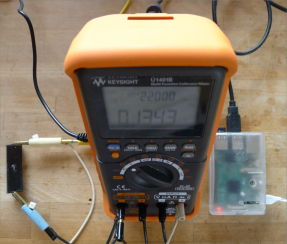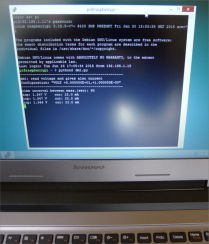

Keysight U1401B is a process calibrator and multimeter in one device. It can source currents ±25 mA and voltages till ±15 V. And at the same time measure as a multimeter. We can use also Escort 2030 with the same behavior. See device description.
We want to follow measured values of voltage an current also on display of a notebook. It is possible, however, also evaluate the data and make some decisions, or write them in a file.
U1401B U5481B Raspberry Pi 2B Notebook
IR <---------------infrared-------------->USB 1 USB Win 8
multimeter serial-USB USB 2<--- >WiFi dongle ((())) Wifi
calibrator cable adapter Raspbian, SSH <-> PuTTY (+WinSCP)
SCPI commands <-> SCPI, Python display, keyboard
U1401B returns lines ended with CRLF ('\r\n') (hex:0D,0A). Therefore reading with readline().

|
( ( ( ) ) ) |

|
# dm1.py
# read voltage and gives also current
# used SCPI commands: CONF?, READ?, CURR?.
import serial
import time
dmm=serial.Serial(port='/dev/ttyUSB0', baudrate=9600, bytesize=7,
parity=serial.PARITY_EVEN)
try:
dmm.open()
except Exception as e:
print ('problem opening port: ' + str(e))
exit()
print ("--------------------------------------------------")
print ('dm1: read voltage and gives also current')
dmm.write('CONF?\r')
dmm.flushInput()
conf = dmm.readline()
print ('Configuration: ' + conf[:-2])
print ("--------------------------------------------------")
sec = input('time interval between meas.(sec): ')
while True:
dmm.write('READ?\r')
dmm.flushInput()
data1 = dmm.readline()
n1 = str(round(float(data1),5))
print 'inp: ' + n1 + ' V',
dmm.write('CURR?\r')
dmm.flushInput()
data2 = dmm.readline()
n2 = str(round(float(data2)*1000,5))
print (' out: ' + n2 + ' mA')
time.sleep(sec)